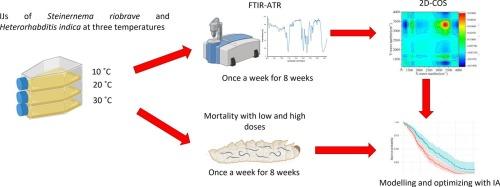Quality control of entomopathogenic nematodes through infrared spectroscopy (FTIR-ATR, 2D-COS): Tracing, modelling and prediction
IF 4.6
2区 化学
Q1 SPECTROSCOPY
Spectrochimica Acta Part A: Molecular and Biomolecular Spectroscopy
Pub Date : 2025-09-23
DOI:10.1016/j.saa.2025.126959
引用次数: 0
Abstract
Entomopathogenic nematodes (EPNs) are widely used in biological pest control, yet their efficacy in field applications is highly dependent on physiological quality during storage; an area lacking direct, predictive quality control tools. Current assessments rely solely on labor-intensive infectivity tests using insect hosts like Galleria mellonella. This study breaks new ground by combining Fourier Transform Infrared Spectroscopy (FTIR-ATR), two-dimensional correlation spectroscopy (2D-COS), and machine learning to deliver a rapid, non-destructive method for evaluating EPNs viability under thermal stress. This study examines the biochemical responses of Heterorhabditis indica and Steinernema riobrave subjected to thermal stress at 10 °C, 20 °C, and 30 °C over an 8 week. Infectivity responses varied significantly between species under thermal stress. S. riobrave declined substantially after six weeks at 30 °C (−55 %), whereas H. indica retained considerably higher infectivity at the same temperature, demonstrating superior thermal tolerance. FTIR spectra revealed temperature- and species-dependent changes across lipid, carbohydrate, and protein spectral regions, indicating distinct biochemical adaptation strategies. Glycogen and triglyceride levels dropped sharply in S. riobrave at 30 °C (up to −65 %), while H. indica exhibited elevated trehalose accumulation, particularly at 20 °C, suggesting enhanced protective mechanisms. Machine learning models showed strong predictive performance., with Support Vector Machine algorithms trained on spectral data accurately predicting infectivity (R2 = 0.93, RMSE = 0.04). Furthermore, 2D-COS analysis highlighted trehalose and protein amide I spectral shifts as early diagnostic markers of thermal stress, preceding observable infectivity decline. Together, these findings introduce a novel, integrative platform for EPNs quality control that is rapid, sensitive, and predictive. This approach offers a transformative advance for commercial biocontrol production, allowing early detection of stress-induced viability loss and optimization of storage protocols to ensure field performance.

利用红外光谱(FTIR-ATR, 2D-COS)对昆虫病原线虫的质量控制:追踪、建模和预测
昆虫病原线虫(EPNs)在害虫生物防治中得到了广泛的应用,但其田间应用效果在很大程度上取决于储存期间的生理品质;缺乏直接的、可预测的质量控制工具的区域。目前的评估完全依赖于劳动密集型的感染性测试,使用的是像mellonella这样的昆虫宿主。该研究通过将傅里叶变换红外光谱(FTIR-ATR)、二维相关光谱(2D-COS)和机器学习相结合,开辟了新的领域,提供了一种快速、无损的方法来评估epn在热应力下的生存能力。本研究考察了在10°C、20°C和30°C条件下8周的热应激下,印度异芽孢杆菌(Heterorhabditis indica)和野芽孢杆菌(steinerma ribrave)的生化反应。在热胁迫下,不同种间的侵染反应差异显著。在30°C条件下6周后,稻花蓟马的传染性显著下降(- 55%),而籼稻蓟马在相同温度下仍保持较高的传染性,表现出优越的耐热性。FTIR光谱揭示了脂质、碳水化合物和蛋白质光谱区域的温度和物种依赖性变化,表明了不同的生化适应策略。糖原和甘油三酯水平在30°C时急剧下降(高达- 65%),而H. indica则表现出海藻糖积累的增加,特别是在20°C时,表明保护机制增强。机器学习模型显示出强大的预测性能。,利用光谱数据训练的支持向量机算法准确预测传染性(R2 = 0.93, RMSE = 0.04)。此外,2D-COS分析强调海藻糖和蛋白酰胺I光谱位移是热应激的早期诊断标志物,在可观察到的感染性下降之前。总之,这些发现为epn质量控制提供了一个快速、敏感和可预测的新型综合平台。这种方法为商业化生物防治生产提供了革命性的进步,可以早期发现应力引起的活力损失,并优化存储协议,以确保现场性能。
本文章由计算机程序翻译,如有差异,请以英文原文为准。
求助全文
约1分钟内获得全文
求助全文
来源期刊
CiteScore
8.40
自引率
11.40%
发文量
1364
审稿时长
40 days
期刊介绍:
Spectrochimica Acta, Part A: Molecular and Biomolecular Spectroscopy (SAA) is an interdisciplinary journal which spans from basic to applied aspects of optical spectroscopy in chemistry, medicine, biology, and materials science.
The journal publishes original scientific papers that feature high-quality spectroscopic data and analysis. From the broad range of optical spectroscopies, the emphasis is on electronic, vibrational or rotational spectra of molecules, rather than on spectroscopy based on magnetic moments.
Criteria for publication in SAA are novelty, uniqueness, and outstanding quality. Routine applications of spectroscopic techniques and computational methods are not appropriate.
Topics of particular interest of Spectrochimica Acta Part A include, but are not limited to:
Spectroscopy and dynamics of bioanalytical, biomedical, environmental, and atmospheric sciences,
Novel experimental techniques or instrumentation for molecular spectroscopy,
Novel theoretical and computational methods,
Novel applications in photochemistry and photobiology,
Novel interpretational approaches as well as advances in data analysis based on electronic or vibrational spectroscopy.

 求助内容:
求助内容: 应助结果提醒方式:
应助结果提醒方式:


